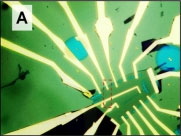What is graphene? Graphene is a single layer of graphite. It is a material which is only one atom thick, yet very strong.
When was it discovered? Who discovered it? People have been making graphene sheets as a bi-product of surface cleaning procedure for years. It is often formed when carbon impurity in metals such as nickel gets pushed out onto surface. Just recently, Andre Geim at University of Manchester in England discovered that these sheets can be produced by mechanically exfoliating graphite on silicon oxide surface.
How would u describe graphene structure? Graphene is 2-D network of hexagonally bonded carbon. Easiest way to describe it is as chicken-mesh with all the vertices replaced by a carbon atom.
What are its electronics properties? Graphene sheets are half way between metal and semiconductor. For this, it is called a semimetal. What is incredible is that electrons behave more like slow light in graphene sheets and also it conducts better than copper by weight. The unique electrons in graphene behave much like divided highway. It’s hard to scatter electron from forward going to backward going.
What are some of the tests you perform on graphene? My group strives to understand fundamental electronic properties in this material. Material is unique; it is small and solely composed of surface atoms. (All the atoms are at surfaces) So surrounding environment can tremendously impact its material  properties. My group adapts unique ultra clean (in fact, atomically clean) approach to study the material properties of graphene.
properties. My group adapts unique ultra clean (in fact, atomically clean) approach to study the material properties of graphene.
Is this single layer material more stable than other two dimensional materials? Why or why not? There are no other free-standing two dimensional materials so the comparison isn’t there. But I would say that graphene is very strong: the best strength/weight in nature due to its robust carbon-carbonbonds.
What are some of the potential uses or applications of this new material?What are some of its drawbacks? Graphene is ultimately transparent and flexible. I think this material can give rise to and inspire fast computers on flexible platforms (i.e. wearable computer that computes as fast as your Dell computers). Drawback is that it’s currently hard to control its synthesis. This problem will probably be solved in next 5 years as there are a lot of funding going into synthesis of graphene.

